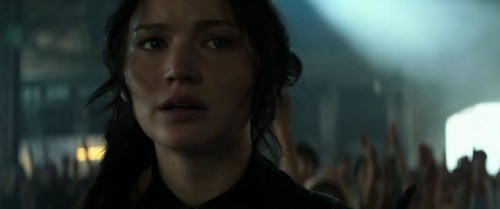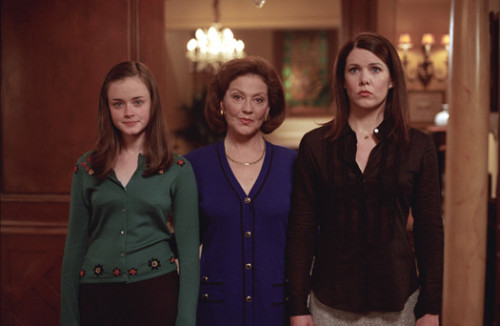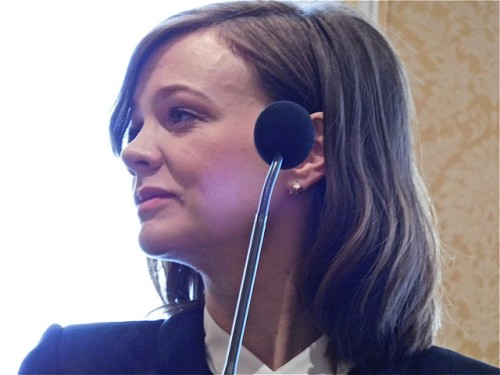Bre Mueck and Matthew Luret at the park in a scene from All Earthly Constraints
This is a guest post by Ryan M. Moore.
My first memory of being exposed to a feminist film (and one of my first memories, period) is of my mom setting up a projector in our basement (8mm? 16mm? I am old), loading it with a reel she had borrowed from the library (yes, you could do that!) and showing my brother and me an animated film called Reverse-a-quake! It was set on an island which was hit by a big earthquake, which caused all of the men to have to switch to doing what had previously been women’s work, and vice-versa. That there was anything political about this storyline sailed right over my 6-year-old head, but knowing what I know now, it must have sunk in a little.
I call myself a feminist without reservation, but I didn’t set out to make a feminist statement, or any kind of political statement, when I wrote and directed my feature film debut All Earthly Constraints. The lead character, Emily (played by the amazing Bre Mueck) is a struggling screenwriter (“Write what you know!”) who works in a gelato shop. Emily’s screenplay is about a struggling screenwriter named Emma (“Write what you know!”) who works in a coffee shop, and is also secretly a superheroine named Emmageddon. Emma is Emily’s “Mary Sue” (a character that is a thinly veiled, idealized version of her author), and Emmageddon is Emma’s. It’s Mary Sues all the way down.
In one scene, Emily has just left her writer’s group in tears after having her script “Emmageddon” savaged (“Self-indulgent! Masturbatory!”) by the sadistic self-proclaimed group leader, John. Soft-spoken Dylan goes after Emily, and they end up talking and drinking at a local park. In the course of their first-ever real conversation, this happens:
DYLAN: I guess I just think about… sometimes, you know, a real job, a family, stability. No “someday when I make it.” Is that so wrong? I mean, haven’t you ever thought you might be worthwhile, or good enough, or whatever, just how you are—just being you?
EMILY: Not even once.
DYLAN: (after a long pause) Me neither.
Shooting this scene was incredibly strange. To hear and see the most honest thing I’ve ever written about the creative process brought to life by two amazing actors, seemed, at the time, like an affirmation of all the choices I’ve ever made. I fell largely on Emily’s side as I thought, “Yeah, I’m doing the right thing with my life.”
Three months later, mired in the post-production process, I can see Dylan’s side too. Maybe it should be enough to just work your job and live your life and be happy with you are. Maybe I would’ve been happier that way. Maybe it’s just my ego that tells me I can’t possibly ever settle for “normal.” It’s been an incredibly difficult process trying to finish this film—making a movie is hard. Trying to do anything well is hard. Life is hard.
Bre Mueck as Emmageddon in a scene from All Earthly Constraints
But what I learned in the process of shooting that scene (and of tangling up my reality and emotional state with that of my character’s to a frankly disorienting extent that I hope would make Charlie Kaufman proud), was this: Emily is not a “strong female character.” Emily isn’t “strong,” at least not exclusively. She starts the scene in tears, and continues by admitting her deepest self-doubts to Dylan, not because she has any real connection with him (yet), but because he’s there and willing to listen and pay for the booze.
And Emmageddon isn’t always “strong” either, even though she’s a self-proclaimed superhero. Who would be interested in seeing a story about someone who was nothing but “strong,” all the time, in every situation? It would be like watching a film about a slab of granite. I don’t know yet if we made a good movie, but I’m pretty sure we made an honest movie—and you can’t do that while you, or your characters, are busy pretending to be “strong.” Being vulnerable, and weak, and pushing ahead anyway is what’s interesting about anyone, fictional or real.
I have a lot of problems with the current crop of superhero movies. While the artistry and craft that goes into their creation is almost literally unimaginable, all too often they exist exclusively in the realm of black and white, “good guys” and “bad guys,” strong, wise-cracking male heroes and female sidekicks who exist mostly as window-dressing, or as sexual conquests for the men. One of my goals in creating All Earthly Constraints was to create a female superhero who was also human: Yes, she kicks, punches, and slaps people who deserve to be kicked, punched and slapped, and she’s good at it. But she has no special powers and she can be hurt, physically and emotionally. Under the costume, she’s still a person. I’m not quite delusional enough to believe that All Earthly Constraints will ever be playing in your local multiplex next to the latest Summer tentpole, but I hope it starts a few conversations, or adds a little bit to some that are already happening.
You can learn more about All Earthly Constraints, and follow or support our crowdfunding campaign at Seed & Spark.
Ryan M. Moore is a writer and director living in Silver Lake, Los Angeles. All Earthly Constraints is his first feature film.




















